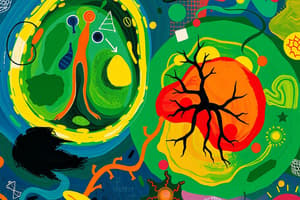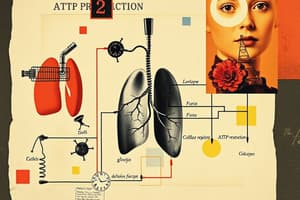Podcast
Questions and Answers
What is the net production of ATP during glycolysis?
What is the net production of ATP during glycolysis?
- 0 ATP
- 2 ATP (correct)
- 4 ATP
- 6 ATP
Which compound is formed from pyruvate during its conversion in aerobic respiration?
Which compound is formed from pyruvate during its conversion in aerobic respiration?
- Acetyl CoA (correct)
- Ethanol
- NADH
- Lactate
What is the primary role of NADH in cellular respiration?
What is the primary role of NADH in cellular respiration?
- To transport high-energy electrons (correct)
- To regenerate oxygen
- To act as an inhibitor of glycolysis
- To directly produce ATP
Which of the following statements about the citric acid cycle is true?
Which of the following statements about the citric acid cycle is true?
How many ATP can be produced from one molecule of FADH2 in the electron transport chain?
How many ATP can be produced from one molecule of FADH2 in the electron transport chain?
What type of metabolism occurs in eukaryotic cells when oxygen is scarce?
What type of metabolism occurs in eukaryotic cells when oxygen is scarce?
Which component is essential in the electron transport chain as the final electron acceptor?
Which component is essential in the electron transport chain as the final electron acceptor?
Which of the following is a product of lactate fermentation?
Which of the following is a product of lactate fermentation?
What happens to ATP levels when ATP binds to the inhibitor site of phosphofructokinase?
What happens to ATP levels when ATP binds to the inhibitor site of phosphofructokinase?
During the process of β-oxidation, what are fatty acids converted into for entry into the citric acid cycle?
During the process of β-oxidation, what are fatty acids converted into for entry into the citric acid cycle?
How do eukaryotic cells regenerate NAD+ during fermentation?
How do eukaryotic cells regenerate NAD+ during fermentation?
What is a characteristic of anaerobic respiration compared to aerobic respiration?
What is a characteristic of anaerobic respiration compared to aerobic respiration?
What is the maximum number of ATP molecules that can be generated from one molecule of glucose in optimal aerobic conditions?
What is the maximum number of ATP molecules that can be generated from one molecule of glucose in optimal aerobic conditions?
What is the net yield of ATP produced during glycolysis?
What is the net yield of ATP produced during glycolysis?
Which molecule is produced from pyruvate during its conversion to acetyl CoA?
Which molecule is produced from pyruvate during its conversion to acetyl CoA?
What is the primary function of the citric acid cycle?
What is the primary function of the citric acid cycle?
Which of the following statements about the electron transport chain is true?
Which of the following statements about the electron transport chain is true?
How many carbon atoms are lost during one turn of the citric acid cycle from one molecule of acetyl CoA?
How many carbon atoms are lost during one turn of the citric acid cycle from one molecule of acetyl CoA?
What is the role of ATP synthase in oxidative phosphorylation?
What is the role of ATP synthase in oxidative phosphorylation?
In which cellular location does glycolysis occur?
In which cellular location does glycolysis occur?
What type of reaction is the conversion of NAD+ to NADH during glycolysis?
What type of reaction is the conversion of NAD+ to NADH during glycolysis?
Which of the following best describes the process of chemiosmosis?
Which of the following best describes the process of chemiosmosis?
During the first phase of glycolysis, glucose is phosphorylated to form which intermediate?
During the first phase of glycolysis, glucose is phosphorylated to form which intermediate?
What molecule is formed as a byproduct of the electron transport chain when oxygen is reduced?
What molecule is formed as a byproduct of the electron transport chain when oxygen is reduced?
What is the primary role of FADH2 in cellular respiration?
What is the primary role of FADH2 in cellular respiration?
What happens to the electrons as they move through the electron transport chain?
What happens to the electrons as they move through the electron transport chain?
What occurs if oxygen is not present during cellular respiration?
What occurs if oxygen is not present during cellular respiration?
Flashcards are hidden until you start studying
Study Notes
Glycolysis
- Glucose is converted into two pyruvates.
- Takes place in the cytosol.
- It does not require oxygen.
- Net yield: 2 ATP and 2 NADH molecules
- Glucose + 2 ATP → 2 pyruvates + 2 NADH + 4 ATPs
Pyruvate Conversion
- Two pyruvates are converted into two acetyl CoA
- Occurs in mitochondria of eukaryotes
- 2 pyruvates → 2 acetyl CoA + 2 CO2 + 2 NADH
Citric Acid Cycle
- Two acetyl CoA are converted into 4 CO2 + 6 NADH + 2 FADH2 + 2 ATPs
- Takes place in the matrix of the mitochondria.
- 2 acetyl CoA → 4 CO2 + 6 NADH + 2 FADH2 + 2 ATPs
ATP Production
- Oxidation of NADH in the electron transport chain yields up to 3 ATPs per molecule
- Oxidation of FADH2 yields 2 ATPs per molecule
- Certain eukaryotic cells expend energy to shuttle NADH across the mitochondrial membrane, so the maximum number of ATPs formed from NADH varies from 28 to 30
Regulation of Aerobic Respiration
- Glycolysis is partly controlled by feedback regulation of the enzyme phosphofructokinase
- Phosphofructokinase has two allosteric sites:
- An inhibitor site that binds ATP (at very high ATP levels)
- An activator site to which AMP binds (when ATP is low)
Energy Yield of Nutrients Other Than Glucose
- Other nutrients are transformed into metabolic intermediates that enter glycolysis or the citric acid cycle.
- For amino acids, the amino group (NH2) is removed and the carbon chain is used in aerobic respiration.
- For lipids, glycerol is converted to a compound that enters glycolysis and fatty acids are converted by β-oxidation to acetyl CoA, which enters the citric acid cycle.
Anaerobic Respiration
- Anaerobic respiration does not use oxygen as the final electron acceptor.
- Used by prokaryotes in environments such as waterlogged soil, stagnant ponds, and animal intestines.
- Electrons from glucose pass from NADH down an ETC coupled to ATP synthesis by chemiosmosis.
- An inorganic substance such as nitrate or sulfate is the final electron acceptor.
Products of Anaerobic Respiration
- End products of anaerobic respiration are CO2, one or more reduced inorganic substances, and ATP.
- Example: Anaerobic respiration in the nitrogen cycle
- C6H12O6+ 12 KNO3 → 6 CO2+ 12 KNO2 + energy
Fermentation
- Does not involve an ETC
- Only two ATPs are formed per glucose by substrate-level phosphorylation during glycolysis.
- NADH molecules transfer H atoms to organic molecules, regenerating NAD+ needed for glycolysis.
Alcohol Fermentation
- Yeasts are facultative anaerobes: can switch to alcohol fermentation when deprived of oxygen.
- Enzymes decarboxylate pyruvate, forming acetaldehyde.
- NADH produced during glycolysis transfers hydrogen atoms to acetaldehyde, reducing it to ethyl alcohol.
Lactate Fermentation
- Certain fungi and bacteria perform lactate fermentation.
- NADH produced during glycolysis transfers hydrogen atoms to pyruvate, reducing it to lactate.
- Vertebrate muscle cells produce lactate when oxygen is depleted during exercise.
Comparing Aerobic and Anaerobic Respiration, and Fermentation
- Aerobic respiration:
- Transfers electrons to ETC
- Terminal electron acceptor is O2
- Final product is water
- ATP synthesized by oxidative phosphorylation, chemiosmosis, substrate-level phosphorylation
- Anaerobic respiration:
- Transfers electrons to ETC
- Terminal electron acceptor is inorganic substances
- Final product is reduced inorganic substances
- ATP synthesized by oxidative phosphorylation, chemiosmosis, substrate-level phosphorylation
- Fermentation:
- Transfers electrons to organic molecules
- There is no ETC
- Final product is alcohol or lactate
- ATP synthesized by substrate-level phosphorylation during glycolysis
Electron Transport Chain
- All electrons removed from a glucose during glycolysis, acetyl CoA formation, and citric acid cycle are transferred as part of hydrogen atoms to NADH and FADH2
- NADH and FADH2 enter the electron transport chain (ETC) where electrons move from one acceptor to another
- Some electron energy is used to drive synthesis of ATP by oxidative phosphorylation
ETC structure
- In eukaryotes, the ETC is a series of electron carriers embedded in the inner mitochondrial membrane
- Electrons pass down the ETC in a series of redox reactions, losing some of their energy at each step along the chain
- Members of the ETC include flavin mononucleotide, ubiquinone, iron-sulfur proteins, and cytochromes.
- The ETC includes four large protein complexes:
- Complex I accepts electrons from NADH
- Complex II accepts electrons from FADH2
- Complex III accepts electrons from reduced ubiquinone and passes them to cytochrome c
- Complex IV (cytochrome c oxidase) accepts electrons from cytochrome c and reduces O2, forming H2O
Final Electron Acceptor
- Oxygen is the final electron acceptor in the ETC
- Lack of oxygen blocks the entire ETC
- No additional ATP is produced by oxidative phosphorylation
- Some poisons also inhibit normal activity of cytochromes
- Example: Cyanide binds to iron in cytochrome, blocking ATP production
Cheiosmotic Model of ATP Synthesis
- Peter Mitchell (1961) proposed that electron transport and ATP synthesis are coupled by a proton gradient across the inner mitochondrial membrane in eukaryotes
- Key Experiment: Bacterial cells placed in an environment with a high hydrogen ion (proton) concentration synthesized ATP even if electron transport was not taking place
Proton Gradient
- Proton gradient is important to drive ATP synthesis
- Protons diffuse from the intermembrane space to the matrix through the enzyme complex ATP synthase.
- Central structure of ATP synthase rotates, catalyzing the phosphorylation of ADP to form ATP.
Maximum ATP Production
- Aerobic respiration of one glucose molecule: yields a maximum of 36 to 38 ATPs
- Glycolysis: 2 ATP + 2 NADH --- converts to 6 ATP
- Krebs cycle: 2 ATP + 6 NADH + 2 FADH2 --- converts to 20 ATP
- Total: 28 ATP
Studying That Suits You
Use AI to generate personalized quizzes and flashcards to suit your learning preferences.




